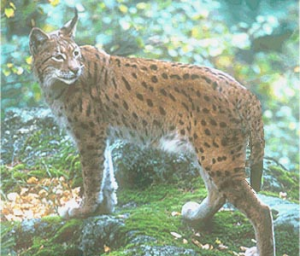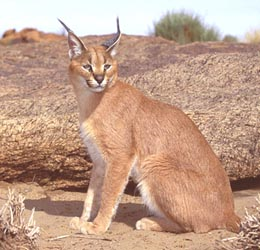Difference between revisions of "Stei"
From World of Entorais Wiki
Jump to navigationJump to search (→Behaviour: content) |
m (Text replacement - "Anexea" to "Annexea") |
||
| (9 intermediate revisions by the same user not shown) | |||
| Line 3: | Line 3: | ||
==About== | ==About== | ||
:Sleek and long bodied felines, with prominent tufts of longer hairs at the points of their ears. Stei are generally nocturnal hunters of small animals. Capable trackers and generally stalk their prey in pairs. | :Sleek and long bodied felines, with prominent tufts of longer hairs at the points of their ears. Stei are generally nocturnal hunters of small animals. Capable trackers and generally stalk their prey in pairs. | ||
;Common Names: | ;Common Names:Dajipm ([[Quzonia]]), Düpa ([[Kythus]]), Kac ([[Tabras]]), Orib ([[Aralia]]), Prudrelä ([[Layor (nation)|Layor]]), Stei ([[Waejir]]) | ||
==Description== | ==Description== | ||
;Classification: | ;Classification:Mammal | ||
;Size: | ;Size: 25 kg (55 pounds), 0.75 metre (2 feet, 5 inches) at shoulder, 1.75 metres (5 feet, 9 inches) length nose to tail. | ||
;Appearance: | ;Appearance:Long bodied, with a medium length tail. Lean legs with large paws containing retractable claws. Their heads are narrow, and possessed of a powerful toothy jaw, and forward facing eyes, large triangular ears with long tufts at the points. Furred in varying patterns and colours suitable to their environment. | ||
;Sexual dimorphism: | ;Sexual dimorphism:Generally males will be slightly larger than females of equivalent maturity. | ||
;Variance: | ;Variance:There exists considerable variation with and between species of stei. Colours and patterns of fur, body frame and size, and tail lengths will denote species distinction. | ||
==Ecology== | ==Ecology== | ||
;Habitat: | ;Habitat:Stei are found throughout Annexea, in all climates and latitudes. They claim a territory suitable for hunting, and will establish a den near its centre. | ||
;Diet: | ;Diet:Stei are obligate carnivores, seldom eating vegetable matter. They hunt a variety of small game and larger animals like [[Cebuc]], [[Rabbuc]], or [[Teica]]. | ||
==Behaviour== | ==Behaviour== | ||
| Line 22: | Line 22: | ||
;Reproduction:Mate in late autumn, litters of 2-6 young born in the spring. Such young are nursed, and taught how to hunt for themselves throughout the summer, and are capable of surviving on their own by their first winter. | ;Reproduction:Mate in late autumn, litters of 2-6 young born in the spring. Such young are nursed, and taught how to hunt for themselves throughout the summer, and are capable of surviving on their own by their first winter. | ||
==Sub-Species== | ==Notable Sub-Species== | ||
===Common Stei=== | ===Common Stei=== | ||
:The common stei has the widest range of colouration and patterns in | :The common stei has the widest range of colouration and patterns in its fur, ranging through all shades of browns, greys and oranges, sometimes in mottled, spotted, brindled or patches of contrasting colours. :They are generally smaller than the more specialized species, and sometimes domesticated as hunting companions and guards by some Treahni people. | ||
===Desert Stei=== | ===Desert Stei=== | ||
| Line 30: | Line 30: | ||
===Great Jungle Stei=== | ===Great Jungle Stei=== | ||
:Largest and most feared of the stei species, the Great Jungle Stei has grey and brown stripes allowing it camouflage when stalking prey in the thick vegetation of | :Largest and most feared of the stei species, the Great Jungle Stei has grey and brown stripes allowing it camouflage when stalking prey in the thick vegetation of its preferred habitat. These felines are fearless predators which will often attack prey much larger than themselves. | ||
===Night Stei=== | ===Night Stei=== | ||
| Line 36: | Line 36: | ||
==Domestication== | ==Domestication== | ||
;General: | ;General:Many cultures will have domesticated stei for hunting, or vermin control roles. | ||
;Resources: | ;Resources:Furs | ||
==Stories== | ==Stories== | ||
| Line 44: | Line 44: | ||
==See Also== | ==See Also== | ||
:[[Tomka]] | |||
[[Category:Fauna]] | [[Category:Fauna]] | ||
[[Category:Mammal]] | [[Category:Mammal]] | ||
Latest revision as of 14:26, 2 July 2024
About
- Sleek and long bodied felines, with prominent tufts of longer hairs at the points of their ears. Stei are generally nocturnal hunters of small animals. Capable trackers and generally stalk their prey in pairs.
- Common Names
- Dajipm (Quzonia), Düpa (Kythus), Kac (Tabras), Orib (Aralia), Prudrelä (Layor), Stei (Waejir)
Description
- Classification
- Mammal
- Size
- 25 kg (55 pounds), 0.75 metre (2 feet, 5 inches) at shoulder, 1.75 metres (5 feet, 9 inches) length nose to tail.
- Appearance
- Long bodied, with a medium length tail. Lean legs with large paws containing retractable claws. Their heads are narrow, and possessed of a powerful toothy jaw, and forward facing eyes, large triangular ears with long tufts at the points. Furred in varying patterns and colours suitable to their environment.
- Sexual dimorphism
- Generally males will be slightly larger than females of equivalent maturity.
- Variance
- There exists considerable variation with and between species of stei. Colours and patterns of fur, body frame and size, and tail lengths will denote species distinction.
Ecology
- Habitat
- Stei are found throughout Annexea, in all climates and latitudes. They claim a territory suitable for hunting, and will establish a den near its centre.
- Diet
- Stei are obligate carnivores, seldom eating vegetable matter. They hunt a variety of small game and larger animals like Cebuc, Rabbuc, or Teica.
Behaviour
- Social grouping
- Mated pairs, or small prides of up to a dozen animals with a singular adult male male.
- Temperament
- Wary, Territorial, or Aggressive
- Intelligence
- Cunning Animals
- Reproduction
- Mate in late autumn, litters of 2-6 young born in the spring. Such young are nursed, and taught how to hunt for themselves throughout the summer, and are capable of surviving on their own by their first winter.
Notable Sub-Species
Common Stei
- The common stei has the widest range of colouration and patterns in its fur, ranging through all shades of browns, greys and oranges, sometimes in mottled, spotted, brindled or patches of contrasting colours. :They are generally smaller than the more specialized species, and sometimes domesticated as hunting companions and guards by some Treahni people.
Desert Stei
- Reddish through golden colours brace the fur of this species. They dwell in underground dens and emerge during the cool evening to hunt by the light of the moon.
Great Jungle Stei
- Largest and most feared of the stei species, the Great Jungle Stei has grey and brown stripes allowing it camouflage when stalking prey in the thick vegetation of its preferred habitat. These felines are fearless predators which will often attack prey much larger than themselves.
Night Stei
- Large nocturnal feline predators found in light-to-heavy forest covered regions of Entorais, preferring some trees for perching and lounging in/under during the day. The fur of these beasts is uniformly black. The only real colour seen on a Night Stei is the pair of golden yellow eyes staring out of the shadows, the pink/red of their mouth, and flash of white teeth. In rare examples subtle grey patterning has been seen, but believed to be mutations, or hybrids with other species of stei.
Domestication
- General
- Many cultures will have domesticated stei for hunting, or vermin control roles.
- Resources
- Furs

